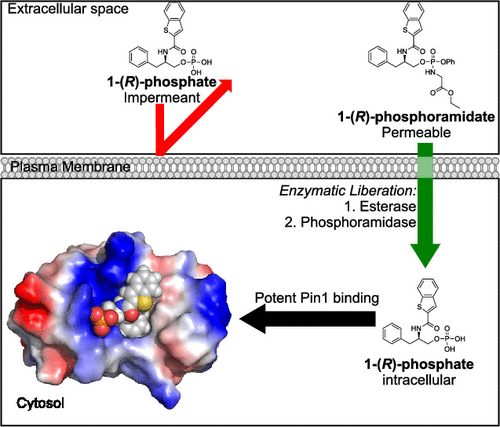当前位置:
X-MOL 学术
›
ACS Med. Chem. Lett.
›
论文详情
Our official English website, www.x-mol.net, welcomes your feedback! (Note: you will need to create a separate account there.)
A Phosphoramidate Strategy Enables Membrane Permeability of a Non-nucleotide Inhibitor of the Prolyl Isomerase Pin1.
ACS Medicinal Chemistry Letters ( IF 4.2 ) Pub Date : 2020-08-10 , DOI: 10.1021/acsmedchemlett.0c00170 Daniel M C Schwarz 1 , Sarah K Williams 1 , Maxwell Dillenburg 2 , Carston R Wagner 2 , Jason E Gestwicki 1
ACS Medicinal Chemistry Letters ( IF 4.2 ) Pub Date : 2020-08-10 , DOI: 10.1021/acsmedchemlett.0c00170 Daniel M C Schwarz 1 , Sarah K Williams 1 , Maxwell Dillenburg 2 , Carston R Wagner 2 , Jason E Gestwicki 1
Affiliation

|
The membrane permeability of nucleotide-based drugs, such as sofosbuvir (Sovaldi), requires installation of phosphate-caging groups. One strategy, termed “ProTide”, masks the anionic phosphate through an N-linked amino ester and an O-linked aromatic phospho-ester, such that release of the active drug requires consecutive enzymatic liberation by an esterase and then a phosphoramidase, such as Hint1. Because Hint1 is known to be selective for nucleotides, it was not clear if the ProTide approach could be deployed for non-nucleotides. Here, we demonstrate that caging of a phosphate-containing inhibitor of the prolyl isomerase Pin1 increases its permeability. Moreover, this compound was processed by both esterase and phosphoramidase activity, releasing the active molecule to bind and inhibit Pin1 in cells. Thus, Hint1 appears to recognize a broader set of substrates than previously appreciated. It seems possible that other potent, but impermeable, phosphate-containing inhibitors might likewise benefit from this approach.
中文翻译:

氨基磷酸酯策略使脯氨酰异构酶 Pin1 的非核苷酸抑制剂的膜渗透性成为可能。
基于核苷酸的药物(如索非布韦 (Sovaldi))的膜通透性需要安装磷酸盐封闭基团。一种称为“ProTide”的策略通过 N-连接的氨基酯和 O-连接的芳族磷酸酯掩盖阴离子磷酸酯,因此活性药物的释放需要酯酶和磷酰胺酶连续酶促释放,例如提示1。由于已知 Hint1 对核苷酸具有选择性,因此尚不清楚 ProTide 方法是否可用于非核苷酸。在这里,我们证明了脯氨酰异构酶 Pin1 的含磷酸盐抑制剂的笼养会增加其渗透性。此外,该化合物通过酯酶和磷酰胺酶活性处理,释放活性分子以结合和抑制细胞中的 Pin1。因此,Hint1 似乎识别出比以前认识的更广泛的底物。其他有效但不可渗透的含磷酸盐抑制剂似乎也可能从这种方法中受益。
更新日期:2020-09-10
中文翻译:

氨基磷酸酯策略使脯氨酰异构酶 Pin1 的非核苷酸抑制剂的膜渗透性成为可能。
基于核苷酸的药物(如索非布韦 (Sovaldi))的膜通透性需要安装磷酸盐封闭基团。一种称为“ProTide”的策略通过 N-连接的氨基酯和 O-连接的芳族磷酸酯掩盖阴离子磷酸酯,因此活性药物的释放需要酯酶和磷酰胺酶连续酶促释放,例如提示1。由于已知 Hint1 对核苷酸具有选择性,因此尚不清楚 ProTide 方法是否可用于非核苷酸。在这里,我们证明了脯氨酰异构酶 Pin1 的含磷酸盐抑制剂的笼养会增加其渗透性。此外,该化合物通过酯酶和磷酰胺酶活性处理,释放活性分子以结合和抑制细胞中的 Pin1。因此,Hint1 似乎识别出比以前认识的更广泛的底物。其他有效但不可渗透的含磷酸盐抑制剂似乎也可能从这种方法中受益。


























 京公网安备 11010802027423号
京公网安备 11010802027423号